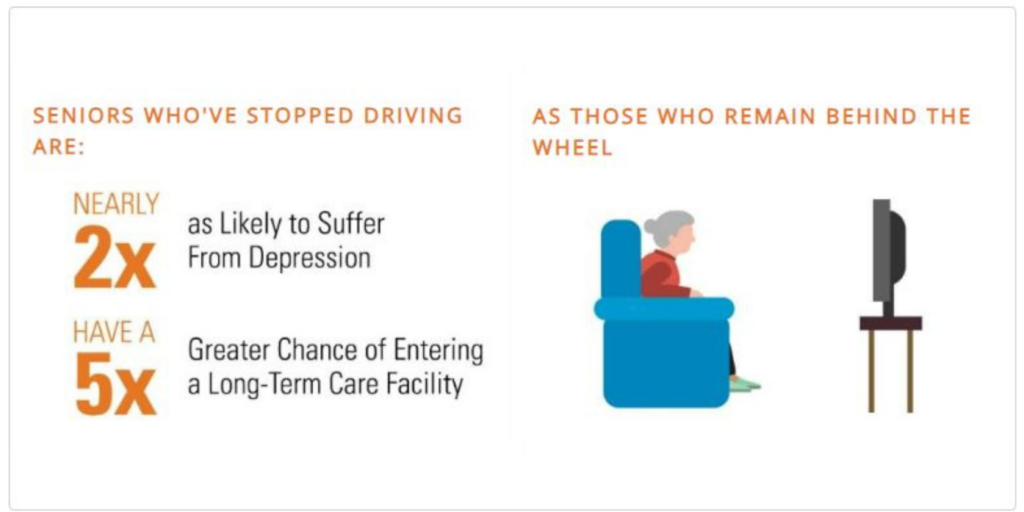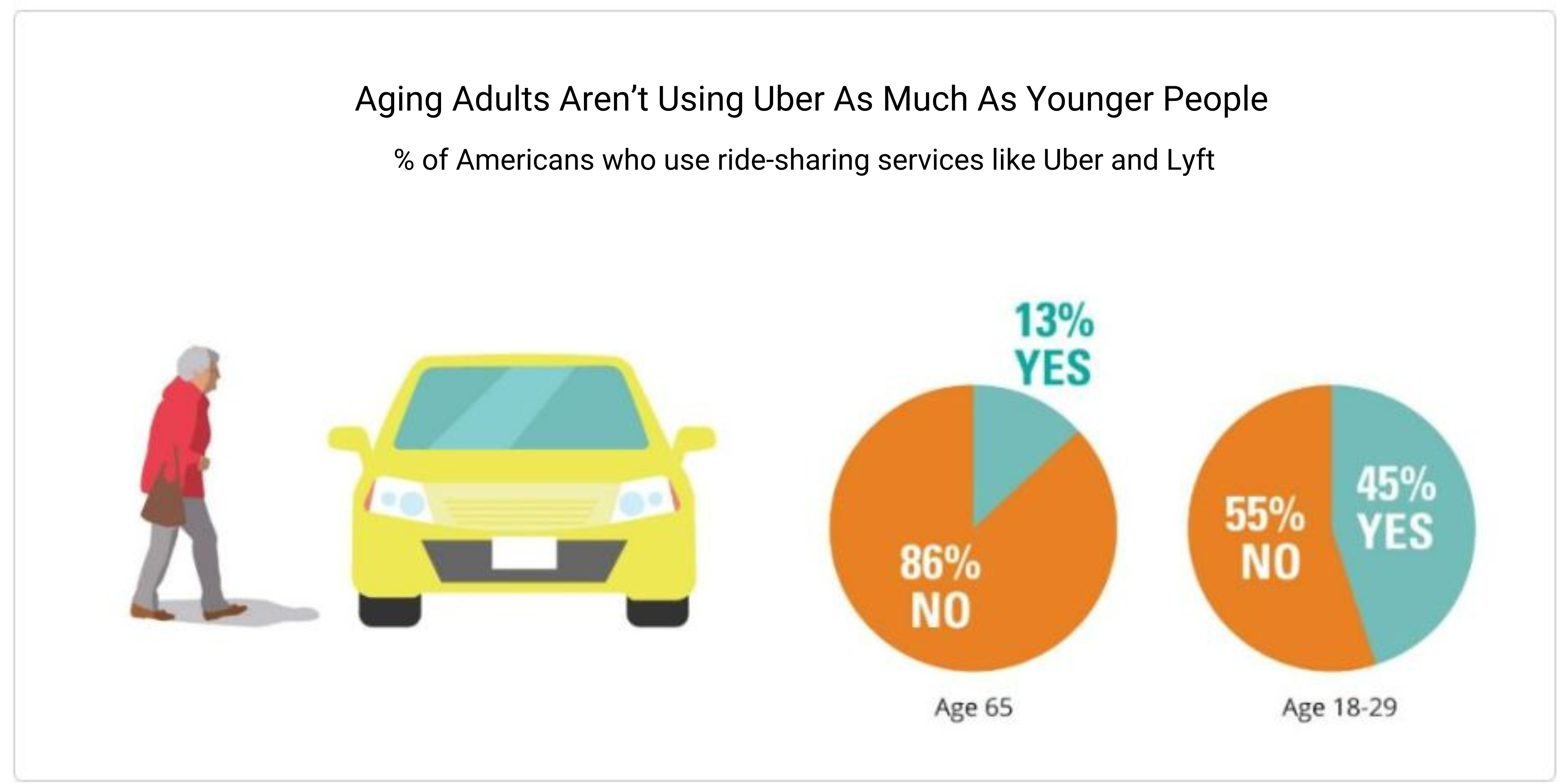Driving is critical to helping aging loved ones maintain their health and independence. But what if it becomes dangerous for them to get behind the wheel?
IN THIS ARTICLE:
- The risk of not driving
- Are aging drivers dangerous?
- Car tech that helps older drivers
In Star Trek, no one had ever solved the Kobayashi Maru training simulation test. It involved choosing to endanger your ship and crew by attempting to rescue the Kobayashi Maru, a civilian vessel in distress, or abandon it, leaving it to certain destruction. Cadet James T. Kirk faced this situation in his Starfleet training and became the first ever to beat the no-win scenario.
Similarly, we might feel like we’re in a no-win scenario when deciding whether an aging loved one should continue driving. If they stop driving, they may be at a higher risk of isolation and depression. But if physical, cognitive, and visual declines are impairing their driving skills, continuing to drive could be dangerous to themselves and others. It’s a good idea to begin preparing for this decision early by considering various outcomes.

First, the Risk of Not Driving
For aging drivers, the thought of not driving may lead to a loss of independence. Not driving means depending on others, family members or friends, for rides to medical appointments, the grocery store, or just places to have fun. After many requests, they can start feeling like a nuisance as a result of asking others to shuttle them around.
There are Other Ways to Get Around, But Change Can Be Difficult
Ride-sharing services like Uber or Lyft can be options to get from place to place. But these services aren’t available everywhere. And aging adults might also be wary of getting into a stranger’s car. Public transportation or taxis can be other options depending on location. But all these options cost money. Therefore, some might be tentative about using them to make trips, especially non-essential trips.

So They May Take Fewer Trips and Stay Home
Staying home limits opportunities for social interaction, which can lead to isolation and, oftentimes, health problems. Seniors who’ve stopped driving are nearly twice as likely to suffer from depression, with a five times greater chance of entering a long-term care facility than those who remain behind the wheel.1 The risks of not driving are significant, so if aging drivers keep driving, how unsafe are they?
Second, How Dangerous Are Older Drivers?
Trying to understand if older drivers are dangerous is difficult. While some studies show that the ability to drive safely decreases with age, the actual number of accidents involving older drivers decreases as age increases.2 Experts attribute this decline to self-imposed limitations, such as driving fewer miles and avoiding night driving, rush-hour traffic, and other difficult conditions. Therefore, sharing the roadways with older drivers poses a relatively low risk to other drivers.2
And Yet Older Drivers Have a Reputation for Being Some of the Most Dangerous Drivers on the Road
Why? Crashes involving older drivers tend to get more media attention. “That’s unfair to the general population of older adults, who are among the safest drivers on the road,” according to Jacob Nelson, director of traffic safety advocacy and research at AAA.
While “older drivers” in general may not pose a large risk on the roads, the risk does seem to increase after age 70. Compared to other age groups, drivers age 70 and older have higher fatal crash rates per mile, yet not as high as young drivers.3 Medical conditions, medication usage, and reduced physical function can increase the risk of accidents and injury among older adults.
Don’t Just Rely on the Stats to Make a Decision
We all have strengths and weaknesses when it comes to driving. And we all have an opinion about our driving ability. That makes it difficult to make decisions about whether an aging driver should stop driving. It’s subjective.
An occupational therapist with specialized training could help with that decision. They can do a comprehensive driving evaluation in a few hours. They can assess someone’s ability to drive and provide a report with their recommendations.
The cost of an evaluation ranges from $250 and $600.4 To find an occupational therapist near you, consult the American Occupational Therapy Association. For tips about how to approach your loved one about having a comprehensive driving evaluation, get The Hartford’s We Need to Talk guide. Next, let’s review car technology that can help make your loved one a safer driver.
Third, Car Tech That Helps Older Drivers
There’s a perception that adding tech gadgets to vehicles will just make driving more complicated and increase the potential for distraction, but that may not be the case. Safe driving tech is designed to work behind the scenes and often only provides alerts when a driver is in an unsafe situation. If your loved one is considering buying a new car, help them actively consider some of the safety gadgets that are now available. AAA offers an online tool, Find the Right Vehicle for You, to help you and your loved one evaluate the options. Here are some to consider:
Automatic braking: Automatically apply brakes if a driver is about to collide with another vehicle or obstruction. Drivers suffering from vision problems and diminished reflex times can benefit. The Insurance Institute for Highway Safety data shows rear-end collisions fall by 50% on vehicles with automatic braking.5 Consider a vehicle that has both forward and rear auto-braking.
Blind Spot Warning: Watches for other cars alongside a driver’s vehicle that the driver may not see. If a car is getting too close, the driver gets an alert. This feature will also alert you if you signal to leave your lane if there’s a car in your blind spot.
Lane Departure Warning: Alerts drivers if their vehicle inadvertently begins drifting into another lane without using a turn signal.
The Find the Right Vehicle for You website can also help you identify the makes and models of cars within various price ranges that may best suit your particular needs, like diminished vision, a limited upper-body range of motion, short stature or being overweight, and decreased leg strength.
Is the Cost of Car Safety Tech Worth it?
Many safety features can be standard in luxury models, but you’ll probably pay extra for these features in mid-level models. And, be aware that your car insurance could increase because the cost to repair these safety features if they’re damaged is more expensive.
An occupational therapist can help you determine which ones are necessary. While the price of a new vehicle equipped with safety options is pricey, these options may help your aging drivers avoid collisions, avoid injuring themselves or others, and maintain a sense of independence—which can make these options well worth the cost.
Remember These Things When Assessing Your Loved One’s Ability to Drive
First, not driving can lead to feelings of being trapped at home and puts people at a higher risk of isolation and depression. Second, old age doesn’t automatically equate to poor driving ability. Third, new technology is available to help meet the needs of older drivers.
Weigh the Outcomes Carefully
When considering whether or not an aging loved one should be driving, it can feel like the Koyabashi Maru dilemma—a no-win scenario. Aging adults who can’t drive may feel trapped and isolated without the freedom to go where they want when they want. Yet, at some point, because of the driving risks, they might have to give up their keys. But car companies have come up with innovative ideas to help solve many of the challenges faced by aging drivers. These new safety features can help aging loved ones reduce the loss of driving skills due to aging and help keep them safely on the road for as long as possible.
Source:
1 More than 80 Percent of Older Drivers Aren’t Talking About Driving Safety, AAA, 8/14/18. Most recent data available.
2 We Need to Talk, The Hartford, 5/18. Most recent data available.
3 Insurance Institute for Highway Safety, 3/21.
4 Your Road Ahead, The Hartford, 4/16. Most recent data available.
5 As Automatic Braking Becomes More Common in Cars, So Do Driver Complaints, The Wall Street Journal, 8/27/19. Most recent data available.
6 Snapshot: Who Uses Ride-Sharing Services in the U.S.? Gallup, 07/18. Most recent data available.

